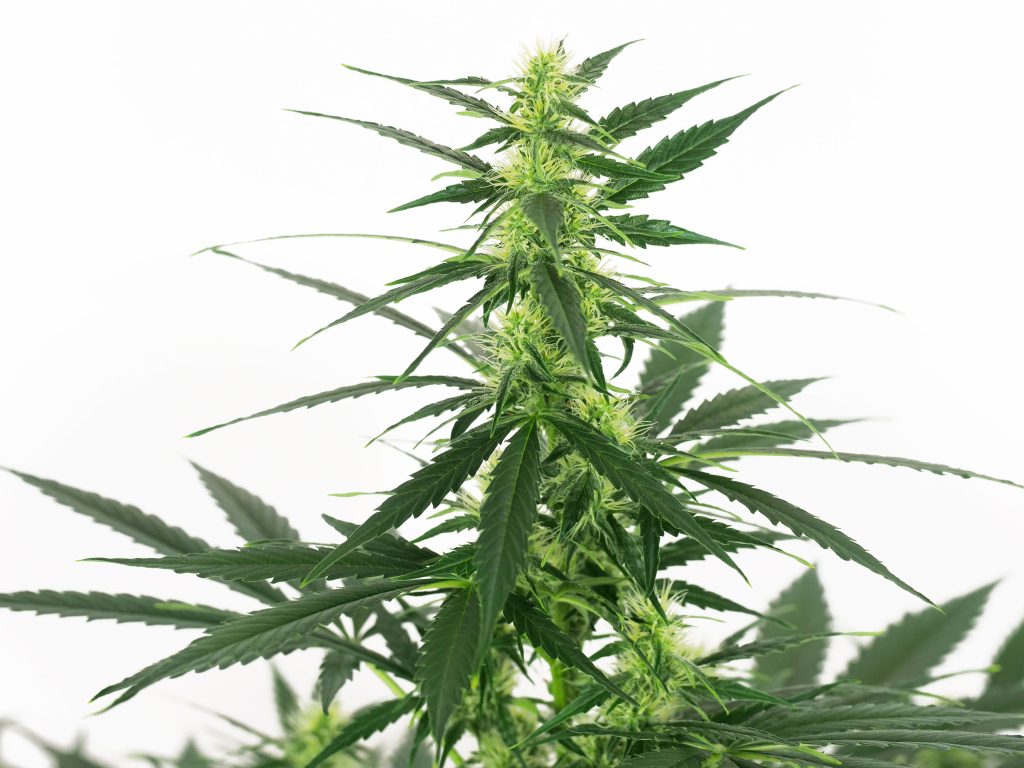An impressive lineage of award-winning parental genetics makes Super Skunk Automatic from White Label an excellent plant for new growers to find success with. It can be grown indoors or outdoors, and the terpene profile of the finished flowers is exquisite. With an 80% indica / 20% sativa lineage, the most common effects reported are an uplifted body stone.
Flowering stage: 71 days
Total time, seed to harvest: 92 days
Final yield: 89 grams
THC content: 22.6%
Super Skunk Automatic by White Label is the result of crossing Skunk #1 with Afghani #1 and then crossing the progeny with a ruderalis to introduce the autoflowering trait. The combination of award-winning genetics and the automatic trait quickly moved this strain to the top of the list to write our next grow diary about.
Super Skunk from White Label is available in regular, feminized, and automatic versions. Do not be confused with the Super Skunk Automatic by Sensi Seeds. The Super Skunk Automatic by White Label offers a unique expression that was selected and refined before seeds were offered to growers. Although the two share the same name, be sure to check out both versions for maximum enjoyment.
We already knew this was an excellent strain for new growers, but to duplicate the experience, we went one step further for this grow report and started from scratch.
Much like a new grower would be, we started by setting up our grow and thoroughly cleaning the cultivation area. Our light was fixed roughly 300 cm from the soil surface, and throughout week one, we used a 600w HPS bulb from Green Power Phillips. Then for the vegetative and flowering stages, we changed to a 1000w HPS bulb from Green Power Phillips.
We circulated air within the upper and lower canopies using multiple fans, recreating the constant airflow and gentle breeze they would naturally receive outside. The nutrients selected for the different stages of our plant’s growth were Bio Grow and Bio Bloom, which offer all the essentials in one bottle.
Lastly, and almost most importantly, we set and maintained our environmental conditions. By controlling temperature and humidity, we control the plant’s uptake of nutrients and rate of photosynthesis.
Our temperature during the 18 hours of lights on was kept at 23 °C. During the six hours of lights off, the temperature was maintained at 21 °C. At different stages during the grow cycle, we lowered our humidity levels, but to start the vegetative period, the humidity was held at 65%.
Germination & seedling
In week one, after all of the prep work, we were excited to finally get growing. We grabbed a pre-moistened jiffy cube and ripped open our pack of Super Skunk Automatic seeds from White Label. We added one seed into our cube and were sure to put the pointed side facing downward.
Within a few days, our Super Skunk Automatic was emerging from its medium. We transplanted it into a 1-litre container of BAC Lava Soil Mix, which contains many nutritious elements ideal for faster growth, and continued to feed our seedling 100 ml of pure water with a pH of 6.2.
To avoid the potential of pest pressure in the garden and on our Super Skunk Automatic, we released a sachet of Hypoaspis Miles. This beneficial insect hunts and eats fungus gnats and thrip pupae.
Vegetation
Automatic varieties have quick vegetative cycles, and throughout week two, we focused on plant strength. Knowing to concentrate on strength during the early stages of growth will help growers later in the cycle. Plant stems and branch development will continue to thrive throughout the different growth stages, creating a sturdy backbone for a heavy yield.
First, we transplanted our Super Skunk Automatic by White Label into a 5-litre container as roots began to protrude from the bottom of the pot. Cultivators of automatic varieties want to allow the roots to grow without touching the bottom of the pot because this is thought to trigger flowering.
Secondly, we made sure the breeze was gently hitting each new leaf. This movement signals the plant to build thicker cell walls and stems. The thicker the branch, the more flower weight it can support. Finally, we turned our Super Skunk Automatic plant 1/2 turn each night. Doing this causes them to move towards the light position, which causes elongation and strengthening of cell walls and stems.
During week three, we began supplementing Bio Grow nutrients into our 100 ml feeding solution while continuing to water around the base of the mainstem. The final solution held an EC of 1.6 with a pH of 6.2.
There was a fair amount of space between the five or six nodes it already had, but we noticed the internodal spacing was closer towards the upper part of the plants. The leaves were a healthy green, and the lower branches had shot up towards the upper canopy. We detected little white hairs on a couple of the nodes, called stigmas, which naturally indicated that flowering was about to begin.
It may sound odd to fight bugs with bugs, but it is an organic and effective way to manage and maintain healthy crops. As such, we released more beneficial insects to our plants, Amblyseius Cucumeris and Amblyseius Californicus, which protected our Super Skunk Automatic from plant-damaging thrip larvae and two-spotted spider mites.
Flowering
It was evident that our Super Skunk Automatic by White Label was now entering the flowering stage in week four. As this is an automatic strain, growers do not need to change the light schedule to begin flowering the plant.
On the first day, we flushed the soil using 1500 ml of pure water and disposed of the runoff from the bottom of our pots. Flushing the soil with a large volume of water can help remove excess nutrients. We are now switching from the Bio Grow to the Bio Bloom nutrients, and this was a good time to flush.
For the remainder of the week, our Super Skunk Automatic received nutrient solution at 1.6 EC, and our Super Skunk Automatic had reached 22 cm by the week’s end. We also released another satchel of Hypoaspis Miles for precaution against pesky predators.
In week five, we increased the EC of our feeding solution to 1.7. The plant was proliferating, and it was able to handle the additional nutrient load. Our Super Skunk Automatic was also drinking faster, so we increased the feeding amount to 250 ml and gradually ramped up to 500 ml by the end of the week.
Each tip of the branches now had an identifiable bud growing. The plant was compact, but the branches had an open enough structure that light could reach all the way to the base. The foliage was sparse, which also allowed maximum light to reach the lower bud sites.
Lower branches grew evenly to create a level shelf of colas below the main apical cola. Due to our Super Skunk Automatic forming flowers, we reduced the humidity to 60%. Although the open plant structure helps with airflow, lower humidity levels are used during flower to help discourage powdery mildew.
During week six, we again increased the EC of our nutrient solution, this time to 1.8, which is the maximum EC for this grow cycle. Like the previous week, we also increased the volume of the solution. We began the week at 500 ml and gradually ramped up to 600 ml each feeding by the end of the week. Our Super Skunk Automatic by White Label was hungry and growing fast.
By week seven, our Super Skunk Automatic had reached 74 cm tall. To ensure we had adequate protection for our plant, we released another sachet of Amblyseius Cucumeris to control thrip larvae and Amblyseius Californicus to combat any two-spotted spider mites.
Our Super Skunk Automatic by White Label was looking extremely healthy. The leaves have a healthy, vibrant green, and each of the fingers is fully extended, absorbing precious light. Each branch tip now had many buds growing into each other to form substantial colas. Stigmas protruded from the many bracts, and trichomes were starting to form on the surrounding sugar leaves.
We began week eight by giving the soil another flush. We poured 1500 ml of pure water through the soil to leech out any build-up of salt-based nutrients and continued the week using 600 ml of solution with a 1.8 EC and a pH of 6.2.
Our Super Skunk Automatic only grew 4 cm from the week before, and it was apparent the plant’s energy was now focused on bud development. The colas on the tip of every branch were rapidly gaining density. No longer could we see small holes through them, and they were firm to the touch.
We had managed to avoid fungus gnats and thrips so far in our grow, but we released one more satchel of Hypoaspis Miles to ensure none of their pupae would cause problems for us in the late stages of our Super Skunk Automatic by White Label grow diary.
In week nine, we saw no vertical growth. The flowers, however, continued to add girth every day. Because moist microclimates can exist within the canopy around large colas, we reduced the room humidity to 58%.
By this time, some of the stigmas had begun to turn brown. Fortunately, we know that stigmas changing colour is not the optimal indicator of plant ripeness. The majority of stigmas remained white, especially on the new, elongated growth of stacked bracts.
Week ten began with a one-day flush using 1500 ml of pure water. All the run-off was removed so the soil could not absorb it, and the feeding schedule for the remainder of the week stayed the same. The buds on the Super Skunk Automatic were becoming enormous. We again lowered the humidity, this time to 52%
It had started a few weeks earlier, but by week eleven, the odour within the garden area was intense, and our Super Skunk Automatic was emitting some powerful aromas. Luckily, our carbon extractor did its job and removed the heavy odour before the air was released outside.
Calyxes are swelling substantially, and the cola is developing a layer of sticky resin glands. We began inspecting trichome heads to gauge the maturity level of the plant. However, we still saw a large number of clear heads and no amber heads on the buds.
Week twelve began with another pure water flush, and we inspected the colour of trichome heads twice this week to gauge and anticipate our harvest window. However, the Inspection indicated the plant had a few more weeks to go, so we continued feeding it for the remainder of the week.
The vertically stacking bracts, also known as fox tails, were growing taller from each of the terminal buds. This gave our Super Skunk Automatic by White label a unique and funky look. When looking at the trichome colour, it is best to inspect the trichome heads on the bud, not the leaves. With foxtails, inspect the bottom bracts instead of the tip of the fox tail to assess plant ripeness better.
Week thirteen was when we decided the end was near and began regular flushes with 1500 ml of water. From this point on, we cut out all nutrients in our solution. The goal is to remove excess nutrients from the soil and cause the plant to use all its stored nutrients.
The leaves had begun to senesce, which was visible by the changing colour. Plants also know when they are close to peak maturity and will offer subtle indicators like this. The foxtails on the Super Skunk Automatic buds create a lot of surface area for trichomes to populate. This easy access to trichome heads makes this bud structure a favourite amongst hash and concentrate producers.
With a ratio of 10% transparent, 80% milky and 10% amber trichome heads, our Super Skunk Automatic was ready to come down. It took only 92 days from seed to harvest. Most of the foliage had already yellowed and withered, which would make for easier and quicker trimming later. It was now time for the next stage of the growing process, the equally important drying and curing stages.
Harvest
The most important thing for a successful dry and cure is the environment. The goal is to slowly release the moisture trapped inside the plant tissue, but not so slowly that mould develops.
The ideal environment for drying is a dark room at 15.5 °C and a constant humidity of 60%. It is also vital to have subtle air movement from a small fan within the drying space. However, avoid blowing air directly at the plants.
Before chopping down our Super Skunk Automatic by White Label, we removed the large fan leaves and any other leaves without trichome coverage. We cut the stalk at the base of the soil and brought the entire plant into the drying area, where it was hung upside-down.
We checked the progress daily. In these conditions, the goal is to have a 14-to-21-day drying time. By day 17, the small branches on our Super Skunk Automatic snapped when bent, and there was a thin layer of dry surface area on the buds. This was the ideal time to trim and jar our buds, and the curing process will rehydrate the slightly dry outer layer of the flowers.
As we trimmed the Super Skunk Automatic, sweet citrus notes with earthy and skunky undertones filled the air. It was enjoyable trimming the leaf matter away from the buds before carefully placing them into jars. We kept the lid off the jars on the first night to release the consolidated moisture from the mass of jarred buds.
For the next two weeks, we remove the lids several times a day for a one-hour duration. Each day the aroma grew stronger. We then kept our Super Skunk Automatic by White Label in the jars to cure for an additional four weeks. During that time, we only opened the jars once daily for the same one-hour duration.
Our buds were then ready to be tested. The majority of our harvest was moved into a C-vault, which maintained a 71% humidity level, which is ideal for storing cannabis long-term. A small portion of our Super Skunk Automatic was sent to a lab for terpene and cannabinoid testing. When we received our results, it showed our Super Skunk Automatic by White Label tested with a THC level of 22.6%.
Terpene profile
Independent lab results showed that myrcene, caryophyllene, and pinene were the three dominant terpenes in our Super Skunk Automatic.
In many ways, this makes sense, from the flavour profile to the overall effects. Myrcene, for example, is not unique to cannabis but is also found in mangoes. It has been shown to have relaxing, sedative effects that can aid with specific pains. Very similar to Super Skunk Automatic, which has a soothing and relaxing effect on people.
The terpene profile became noticeable in early flowering and matured throughout the final weeks. With the flower in our hand, we are bathed in a sweet, skunky scent that bites the nose. Undertones of earthiness follow behind and round out the overall terpene profile.
The flavour profile was similar but with some added nuances. We detected the fruity, skunky, earthiness, but mixed in were hints of pepper and sandalwood, which attributed to the caryophyllene in our Super Skunk Automatic.
Effects from our Super Skunk Automatic by White Label were immediate. A euphoric cerebral high took over initially before giving way to a mind-calming and relaxing body stone. The effects were calm and mellow, which is an excellent combination for novices and connoisseurs alike.
The outcome
What a blast, we had fun growing the Super Skunk Automatic by White Label. Easy to manage, no special training required, no special diet. She was a rockstar from beginning to finish! We discovered that with the speed at which this plant finishes, outdoor gardeners in many areas could potentially yield two harvests per year. That is amazing!
Once our Super Skunk Automatic was harvested and dried, we weighed the flowers and yielded 89 grams of wonderful-smelling buds with a THC level of 22.6% in just 92 days. Super Skunk Automatic by White Label is an excellent plant for novice growers looking for a bumper yield with guaranteed success. It is available in regular, feminized, and automatic versions.
If you enjoyed this grow report, please know that we also did a grow report for the Super Skunk Automatic by Sensi Seeds. You will notice that Super Skunk by Sensi Seeds has a slightly longer flowering time, and the bud structure differs in appearance.
What has your experience with automatic varieties been? Have you ever grown Super Skunk Automatic from White Label? Please let us know your experiences in the comment section below, and be sure to check out the Sensi Seeds grow report archive!
-
Disclaimer:Laws and regulations regarding cannabis cultivation differ from country to country. Sensi Seeds therefore strongly advises you to check your local laws and regulations. Do not act in conflict with the law.
- SEO Powered Content & PR Distribution. Get Amplified Today.
- Platoblockchain. Web3 Metaverse Intelligence. Knowledge Amplified. Access Here.
- Source: https://sensiseeds.com/en/blog/super-skunk-automatic-white-label-grow-report/
- 1
- 100
- 7
- a
- Able
- About
- access
- Act
- added
- Additional
- After
- against
- Aid
- AIR
- All
- already
- Although
- amber
- amongst
- amount
- and
- Another
- anticipate
- apparent
- AREA
- areas
- around
- auto
- Automatic
- available
- award-winning
- Backbone
- base
- because
- becoming
- before
- began
- Beginning
- behind
- below
- beneficial
- BEST
- Better
- between
- Bloom
- Blowing
- body
- Bottom
- Branch
- branches
- brought
- bugs
- build
- called
- cannabis
- carbon
- carefully
- Cause
- causes
- change
- changing
- check
- chopping
- Cleaning
- clear
- Close
- closer
- cola
- combat
- combination
- come
- comment
- Common
- concentrate
- conditions
- conflict
- confused
- constant
- Container
- contains
- content
- continue
- continued
- continuing
- control
- controlling
- could
- country
- Couple
- coverage
- create
- Creating
- crops
- cure
- Cut
- cycles
- daily
- Dark
- day
- Days
- decided
- detected
- developing
- Development
- DID
- Diet
- differ
- different
- directly
- discovered
- doing
- dominant
- down
- downward
- dry
- during
- each
- Earlier
- Early
- easier
- EC
- effect
- Effective
- effects
- elements
- eleven
- emerging
- energy
- enjoyable
- enormous
- enough
- ensure
- Entire
- Environment
- environmental
- equally
- especially
- essentials
- Ether (ETH)
- EVER
- every day
- example
- excellent
- excited
- experience
- Experiences
- extremely
- facing
- fair
- fan
- fans
- FAST
- faster
- few
- fight
- filled
- final
- Finally
- Find
- Firm
- First
- fixed
- Flushed
- focused
- follow
- form
- Fortunately
- found
- from
- fully
- fun
- further
- gaining
- Garden
- Genetics
- gentle
- get
- Giving
- Go
- goal
- good
- gradually
- Grams
- Green
- Grow
- Growing
- grown
- Growth
- guaranteed
- handle
- harvest
- hash
- heads
- healthy
- Held
- help
- helps
- High
- hints
- hitting
- Holes
- HOURS
- However
- HTTPS
- Hungry
- ideal
- immediate
- important
- impressive
- in
- increased
- Indicator
- Indicators
- initially
- instead
- introduce
- IT
- Job
- Know
- Knowing
- known
- lab
- Label
- large
- Late
- LAVA
- Law
- Laws
- Laws and regulations
- layer
- Level
- levels
- light
- List
- little
- load
- local
- long-term
- longer
- Look
- looking
- Lot
- made
- Main
- maintain
- Majority
- make
- MAKES
- manage
- managed
- many
- Mass
- Matter
- maturity
- max-width
- maximum
- medium
- mixed
- ML
- more
- most
- move
- movement
- multiple
- name
- Near
- Need
- New
- next
- night
- nodes
- nose
- Notes
- novice
- number
- offer
- offered
- Offers
- ONE
- open
- opened
- optimal
- organic
- Other
- outdoors
- outside
- overall
- Pack
- part
- Peak
- People
- period
- placing
- plants
- plato
- Plato Data Intelligence
- PlatoData
- please
- Point
- position
- potential
- potentially
- power
- powerful
- Precious
- pressure
- previous
- problems
- process
- Producers
- Profile
- Progress
- protected
- protection
- put
- Quick
- quicker
- quickly
- rapidly
- Rate
- ratio
- reach
- reached
- ready
- receive
- received
- Reduced
- refined
- regarding
- regular
- regulations
- release
- released
- remained
- remove
- Removed
- report
- Reported
- required
- result
- Results
- ripped
- Rockstar
- Room
- roughly
- round
- same
- schedule
- Section
- seed
- seeds
- selected
- sense
- set
- setting
- several
- Share
- Shelf
- shown
- signals
- similar
- Sites
- SIX
- Slowly
- small
- So
- so Far
- solution
- some
- Sound
- Space
- special
- specific
- speed
- stacked
- stacking
- Stage
- stages
- start
- started
- Starting
- stayed
- Step
- Still
- STONE
- stored
- strength
- strengthening
- stronger
- strongly
- structure
- substantial
- success
- successful
- such
- Super
- support
- Surface
- Surrounding
- sweet
- Terminal
- Testing
- THC
- The
- the Law
- their
- therefore
- thing
- this week
- thoroughly
- thought
- three
- Thrive
- Through
- throughout
- time
- times
- tip
- to
- top
- touch
- touching
- towards
- Training
- transparent
- trigger
- TURN
- Turned
- unique
- us
- use
- vibrant
- visible
- vital
- volume
- Water
- ways
- week
- Weeks
- weight
- which
- while
- white
- will
- within
- without
- Work
- would
- write
- year
- Yield
- Your
- zephyrnet
















